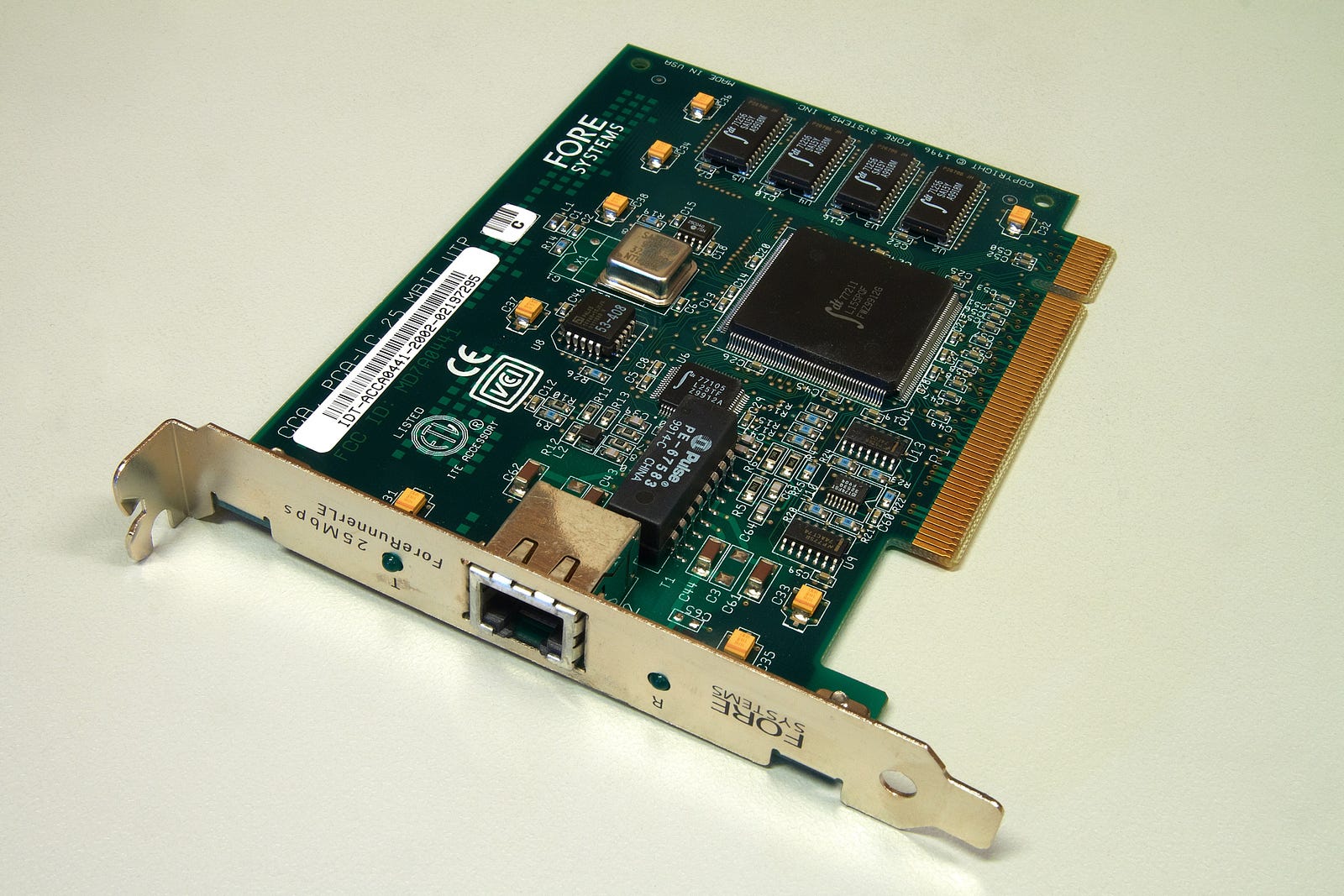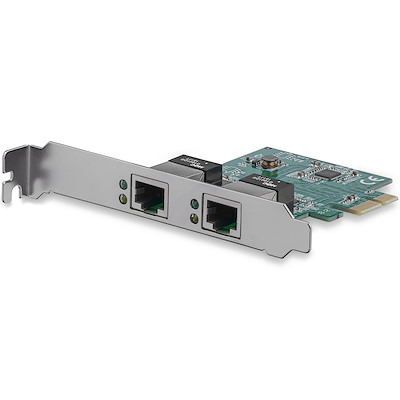Nic Slot
A Network Interface Card (NIC) is a computer hardware component that allows a computer to connect to a network. NICs may be used for both wired and wireless connections. A NIC is also known as a network interface controller (NIC), network interface controller card, expansion card, computer circuit board, network card, LAN card, network adapter.
Stands for 'Network Interface Card' and is pronounced 'nick.' A NIC is a component that provides networking capabilities for a computer. It may enable a wired connection (such as Ethernet) or a wireless connection (such as Wi-Fi) to a local area network.
In internal networks cards, motherboard has a slot for the network card where it can be inserted. It requires network cables to provide network access. Internal network cards are of two types. The first type uses Peripheral Component Interconnect (PCI) connection, while the second type uses Industry Standard Architecture (ISA). Four Gigabit Ethernet ports to a client or server or workstation through one PCI Express slot; 4-Port PCI Express Gigabit network adapter card / Quad-port Gigabit NIC; PCIe 10/100/1000 Network Card; Cost-effective network connectivity with 4x 10/100/1000 RJ45 ports on one adapter card; Full-Duplex Flow Control support; Wake-on-LAN and remote. Network Interface Card (NIC) is a hardware unit, which is inbuilt inside a computer provided with a slot, it connects the computer to a computer network for communication with other devices via buses.
NICs were commonly included in desktop computers in the 1990s and early 2000s. In the 1980s and early 1990s, many computers did not include networking capabilities, so a NIC could be added as an expansion card. Most NICs were installed in a PCI slot on the motherboard. Early NICs included a BNC connector for coax network connections, though Ethernet ports soon became the standard. Therefore most NICs include one or more Ethernet ports.

As wireless networking became more popular, wireless NICs also grew in popularity. Instead of an Ethernet port, wireless NICs are designed for Wi-Fi connections and often have an antenna to provide better wireless reception for the computer. Older wireless cards have PCI connections while most modern wireless NICs connect to a PCI Express slot.
Since many different networking standards exist, it is best to match the specifications of a NIC to the standard of network. For example, if you are connecting to a Gigabit Ethernet network, a Gigabit Ethernet NIC is the best choice. A 100Base-T card will work, but you will only get 1/10 of the possible data transfer rate. A 10 Gigabit Ethernet Card may also work, but you will only experience gigabit speeds on the network. Wireless cards also use the lowest common denominator between the network and the NIC. However, if a wireless card does not support a newer wireless standard (such as 802.11ac), it may not be able to connect to the network.
NIC vs Network Adapter
Technically, a NIC is a physical card that connects to an expansion slot in a computer. Many computers and wireless devices now include an integrated networking component called a network adapter. This may be an Ethernet controller and port attached to the edge of a motherboard or a small wireless networking chip located on the motherboard. A network adapter may also be a small peripheral that connects to a USB port. While the terms 'NIC' and 'network adapter' are often used synonymously, a NIC is a type of network adapter while a network adapter is not necessarily a NIC.
Updated: March 14, 2018
Network Interface Card (NIC) is a hardware unit, which is inbuilt inside a computer provided with a slot, it connects the computer to a computer network for communication with other devices via buses. There are many synonyms for network interface card like, network adapter, local area network (LAN) card or physical network interface card, ethernet controller or ethernet adapter, network controller, and connection card. Network interface card supports almost all standard buses for data transfer between the computers or devices. The connectors or buses act as an intermediator for communication converts the communication between various devices from serial communication to parallel communication or parallel communication to serial communication. It also formats data based on the architecture of the network. This article discusses an overview of What is a wireless network interface card, and its types.

What is a Network Interface Card?
Definition: Network interface card NIC is a hardware component, where network controllers are integrated on to a circuit board that uses standard OSI model of 7 layers to communicate and it acts like a trans-receiver, where it can transmit and receives at the same time while communicating with other devices. Suppose if we want to communicate with another device, let us assume the case of client and server, where the communication between them takes place by firstly sending signals to the physical layer, and then transmitting data packets to the network layer which is an interface at TCP/IP. Connection to the motherboard is made using any one of the following via
- PCI connector
- ISA connector
- ISA connector
- PCI-E
- FireWire
- USB
- Thunderbolt.
The connection to the network is made via any one of the following
- Ethernet
- Token – Ring
Functions of NIC
Nik Sloter Serija
- It acts like a translator, which converts data into a digital signal.
- Communication can be either by using cable wire or by the router which is wireless over the server network
- To communicate over a long distance a network adapter is used.
Types of Network Interface Cards
There are two types NIC they are,
- Ethernet NIC
- Wireless Network NIC
Ethernet NIC
Ethernet NIC card is a slot for a cable where we have to plug one end of the ethernet cable into the slots of the computer and another end of the cable is plugged into the modem, likewise, various devices are connected to make a communication set up between them. There are three standards in Ethernet they are
- 5-Base T: It was developed in 1973, which can transmit, paragraphs using coaxial cable up to a distance 1000mts.
- 10-Base T: It was developed in 1987, it uses twisted cables like telephonic cables for communication.
- 100-Base T: It is also known as fast ethernet, the speed of data transmitted is very high.
- Gigabit Ethernet: It is also named as 1000-Base T ethernet, the special feature of this is it increases the network bandwidth up to 10 times, which can transmit up to 1000mbps of data.
Wireless Network NIC
Wireless network NIC cards consist of a small antenna integrated onto the card, where the communication between various devices is set up wirelessly using the router and various network protocols. One such example of a wireless network NIC card is fiber data digital interface FDDI. In a case where data has to be transmitted over long distances, in such cases, a fiber data digital interface FDDI concept is used which translates data into digital pulses and communicates using optical fiber. FDDI is ring-type architecture, which is of 100mbps, transmission, and retransmission for a long distance is an advantage of FDDI.
Components of Network Interface Card
The main components of the Network Interface Card are as follows
- An external Memory is used to store the data temporarily and uses the stored data whenever required while processing the communication.
- Connectors are used to make the physical link between cables and plugin with the board, this type of connection is especially seen in Ethernet type of NIC cables.
- A Processor converts the data message into a signal format for communication to take place easily.
- Different types of standard Buses are plugged into Buses Connector slots, based on the compatibility of the operation process buses are chosen.
- Jumpers or Dual in package switches are used to control the communication operation, which is either by turning on or turning off the switch.
- MAC address which is a unique identity address is given to network interface card where ethernet packets are communicated with the computer. MAC address is also known as a physical network address.
- A router is an NIC device that is used to connect wirelessly to the internet.

Working of NIC
Nik Sloter Serija
The Functions of the network interface card is, it acts like a bridge connecting multiple computers using LAN – local area network or router, which is plugged into the NIC card slot. Considering a live scenario of corporate offices, for a better understanding of the concept.
In a company there may be many computers provided with WiFi access, where each employee is assigned with one computer to work when the employee wants to access the company website to update his day to day work status, he is provided with his login credentials. He can only log in to his profile based on two scenarios, one is a proper internet connection which can be either wired or wireless connection and other correct login credentials. Here come a few questions about network interface card NIC concept that is, how the network is connected and how data transfer takes place?

Nik Sloter
These computers which are connected to NIC communicate over the internet where the incoming data travels along the media is received by NIC. These bits which are received formatted into frames, CRC (cyclic redundant code) is compared with CRC (cyclic redundant code) in the frame trailer and calculated using CRC (cyclic redundant code) algorithm. If CRC (cyclic redundant code) doesn’t match it means the frame is damaged/changed and it is discarded. This kind of situation is rarely observed in an electrically noisy environment.
Another case where if the CRC (cyclic redundant code) is ok, the destination MAC address is checked, if it is matching the network interface card of the broadcast frame, then the frame is processed forward else discarded. Once the MAC address is verified, the frame header and trailer are stripped creating a packet that is transmitted using network protocols for further processing. This is the actual job of NIC in one direction.
Now for an out-going data, the reverse process is used. The network protocol transfers a packet to the NIC. The NIC adds the source and destination MAC address as the frame header and calculates the CRC for the trailer. Now the frame is ready to transmit. The NIC converts the frame for transmission onto the medium as bit signals.
Advantages
The advantages of the Network Interface Card are as follows
- The communication speed using the Internet is high usually in Gigabytes
- Highly reliable connection
- Many peripheral devices can be connected using many ports of NIC cards.
- Bulk data can be shared among many users.
Disadvantages
The disadvantages of Network Interface Card are as follows
- Inconvenient in case of wired cable NIC, as it is not portable like a wireless router
- The configuration should be proper for better communication.
- Data is unsecured.
Applications
Nic Slot
The applications of Network Interface Card are as follows
- The computer uses NIC for data exchange over a network like documents, images, files, etc.
- Applicable for wireless communication devices like Firewalls, Bridges, Repeater.
- Applicable for wired communication devices hubs, switches, router, smartphones, etc.
Nic Sloter
Thus, this article briefs out about network interface card or network interface controller which is an electronic hardware component integrated with computers. The main purpose of this is to communicate with other devices either wired or wirelessly. In this article, we have seen types of NIC, it’s working with an example, advantages, disadvantages, and applications. The main vendors of network interface cards are Intel, Cisco, D-Link, etc. Here is a question “Which type of Network Interface Card is used in Smartphones?”.
Nik Sloter

